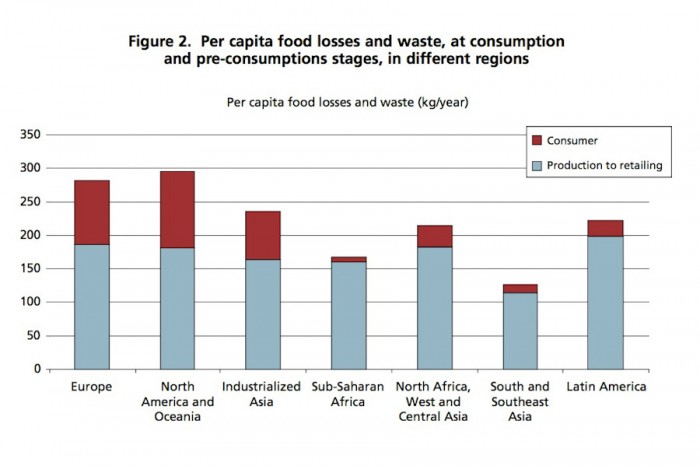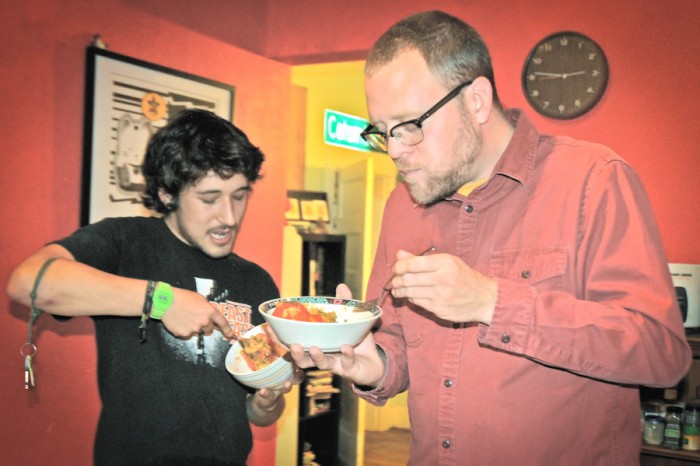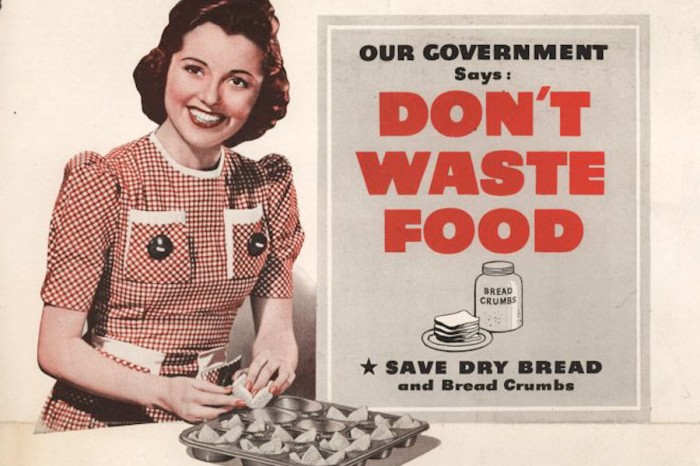Rummaging through garbage bins behind large upscale grocery stores in Seattle, Justin Phillips, Fred Marshall and their friends find bottled smoothies, gourmet sandwiches, produce and more. Phillips and Marshall, who are both bike messengers, dumpster dive because it cuts down on food expenses.
But they also do it out of conviction.
Phillips said he started to practice a ‘freegan’ lifestyle after working in restaurants and seeing how much goes to waste, as well as working on farms and considering how much energy already went into producing food that won’t get eaten. ‘Freegan’ is a derivation of ‘vegan’ that’s used to describe people who prefer to forage or dumpster dive for their food.
“I see tons of wasted food,” said Marshal, who hits mostly grocery store dumpsters, but also frequents places like pizza parlors and even local food production plants that he’d rather not mention by name. “I know that there are fucking people all over the world that need food. Why is this here? There’s got to be something that we can do so that this isn’t here.”
Marshall shook his head thinking out loud about the complexity of the problem. “There’s too many steps for me to count,” he said.
Phillips attributed the problem to industrial farming, saying that too much is produced in the first place. He also worried about imported food and the potential insecurity it was causing poor farmers in other countries. “Food shipped out of their country to the U.S. while they’re starving. That’s fucked up,” he said.
Read Part 2: How to Break Our Addiction to Food Waste
When concerns are raised about global hunger and how to feed a growing world population, the obvious response is to find ways to produce more food. But some activists argue that we already have enough food to feed all the hungry people. What we’re experiencing is actually a distribution problem, not a production problem.
“When people talk about the need to increase global food production to feed those 9 billion people that are expected on the planet by 2050… the fact is: we have an enormous buffer in rich countries between ourselves and hunger,” said UK-based activist Tristram Stuart in a TED talk.
Food loss and waste, according to the U.N. Food and Agriculture Organization (FAO), happens all along the supply chain, though the problem is worse at different points for different regions of the world. In the Global North, waste is most prominent at the consumer and retail level. Portions too large to finish at a comfortable family restaurant or bags of salad mix gone bad after being bought in bulk at a big box superstore.
The Global South experiences food loss largely post-harvest, but pre-consumer, often from inadequate storage or transportation. For example, Kenya’s people have suffered food loss from maize contaminated by aflatoxin due to improper storage. Aflatoxin poisoning can result in liver failure and even death.
The reality, however, is that the level of food loss at the farm or food-processing level is relatively similar between the Global North and the Global South. It’s just that the Global North also has a significant amount of food waste by retailers and consumers.

According to an FAO report, post-production loss has much to do with post-harvest crop grading of agricultural products by retailers — essentially choosing which produce will sell best based on appearance or convenience of processing.
Dana Gunders, a staff scientist at the U.S.-based Natural Resources Defense Council, said that there are no substantial studies on waste in the U.S. that go down to the farm level. Understanding the whole food system — beginning at the farm — is needed to reduce waste, she said.
Nipping the problem at the source would also help reduce wasted energy and water consumption.
As Stuart has pointed out, poor farmers in other countries may actually be growing food for a market in the U.S. or Europe. This means, he’s observed, that bananas can be discarded in Ecuador because they’re the wrong shape or size for U.S. or European grocery retailers. So, in a world connected through supply chains beginning in tropical tree farms and ending in mango smoothies at a nearby shopping mall, how do we tackle food waste?
Solutions are not easy, but a movement has been brewing in Europe, and it’s spreading in the U.S. Stuart’s own organization, Feeding the 5000, runs a number of global campaigns to raise awareness, including hosting dinners cooked from food that would have otherwise been wasted. The dinners are giant communal gatherings of up to 5,000 people in public places like Trafalgar Square in London — basically a super-sized version of a dinner that I went to in Beacon Hill with Phillips, Marshall and friends. The organization has made attempts to expand to the U.S., including a conference on Oct. 16, World Food Day in Oakland, California.

Stuart, who has spent a fair share of his time talking to farmers and poking around dumpsters behind supermarkets and factories, said in the TED talk, that retail and consumer waste is just the “tip of the iceberg… When you start going up the supply chain, you find where the real waste is happening on a gargantuan scale.”
Back in the U.S., there has been progress made in getting grocery chains to donate more fresh food to food banks. According to Food Safety News, for underprivileged families 15 years ago, a visit to the food bank would only yield canned food or bakery items — no fresh vegetables or nutritious proteins from fish or meat.
But in 2002, Western Washington’s Food Lifeline helped launch a ‘Grocery Rescue’ program at QFC stores (which are owned by Kroger, the country’s largest supermarket chain) to help establish national food safety standards for grocery stores donating to food banks.
Today Grocery Rescue arranges for the pickup, delivery and safe handling of many of these items that were otherwise being wasted. Food Lifeline estimates that it saves an average of 16 million pounds of food from being wasted in Western Washington each year.
But it’s obvious that there is still a lot of waste — otherwise freegans like Phillips and Marshall wouldn’t be finding so much good stuff to eat. Think of everything that’s thrown away from grocery stores, restaurants, farmers markets, cafeterias and catered events, not to mention our own homes.
Phillips, who started following freegan lifestyle in 2005, said that he has observed a change in the amount of good food he sees discarded… very slowly.
“We still live in a culture of waste,” he said.
Read Part 2: How to Break Our Addiction to Food Waste



Thanks. That was enlightening. I will try to keep this in mind and share it!